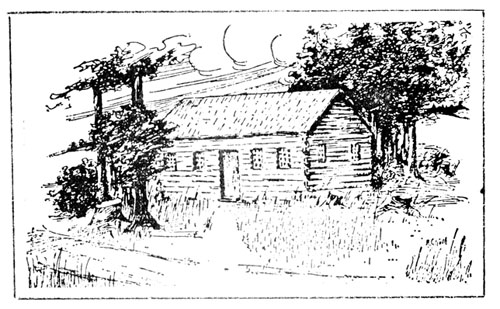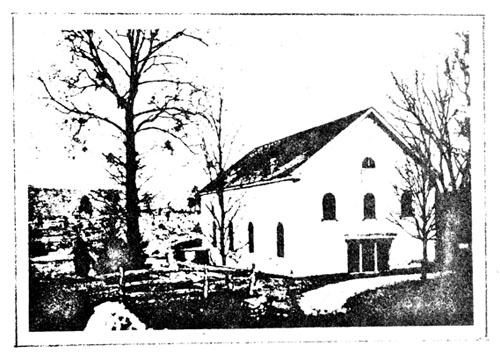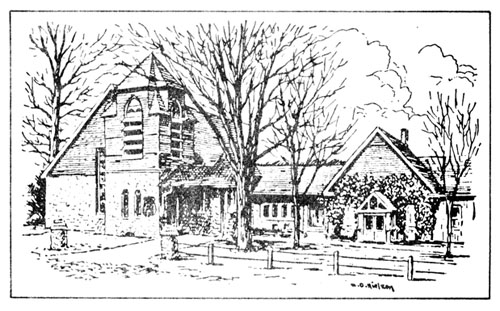|
Home : Quarterly Archives : Volume 22 |
Tredyffrin Easttown Historical Society |
|
Source: October 1984 Volume 22 Number 4, Pages 119–123 Great Valley Presbyterian Church Since two excellent articles about Great Valley Presbyterian Church have appeared in earlier issues of the Quarterly - one by Mrs. Ruth Moore Styer, in November 1953; and the other by Mrs. William Latta Nassau, in October 1967 - this will be more of an "update" on the Church, to tell about the ways we have expanded our facilities, and also about some of our antiques, Mrs. Albert Pentecost also deserves our everlasting "thank you" for the two to three years she spent in reading material found at the church and visiting the Chester County Historical Society and County Archives. She has put together several notebooks, which now comprise our archives, and has given us a history of everything! The notebooks are also fascinating - and fun to read! We are also indebted to several of the older families in the church who saved programs and various articles, which they have donated to us. Miss Edith Hughes was one of these persons, as were Mrs. William Bavis, the Dickersons, the Fetters family, and Mrs. Nassau and other members of the Wilson family. (Pat Nassau was, of course, also a Wilson.) Probably the two oldest articles belonging to the church are the upping block along Swedesford Road, used to get into and out of carriages, and an old pewter plate, the only piece left from our original communion service. The original service was used up to 1828. Wally Weaver took it to Winterthur for a carbon test, which showed it to be made of tin, copper, and lead, from an old formula that goes back to the time of Solomon and was brought over from England. The plate was dated as between 1735 and 1780. Mention of Miss Edith Hughes reminds me that the newest thing at the church is our sign, planned and executed by Harry McAllister and some of our other Trustees. The base is of blue limestone, found by Wally Weaver; he looked many places before finding stone that matched the church buildings, at the site of the old Hughes barn, no longer standing, on Cedar Hollow Road. On our sign we say that the church was founded "prior to 1710" because we cannot document an earlier date. (We believe that it may go back as far as 1684!) We do know that this was the first Presbyterian church in Pennsylvania to be built outside of Philadelphia. We believe that the original parcel of land for the church was donated by James Parry, who owned several hundred acres here in the Valley. It comprised about three or four acres originally, but over the years we have acquired additional land and now have about ten acres. The original church was a log cabin, built in 1720. It was in use for about 75 years. It had no heat, so for almost three-quarters of a century services during the winter months were rather uncomfortable! It was located up the path from the vault, behind the present church. We know its approximate location because Thomas Hutchinson, who died in 1833, stated he wanted to be buried under the spot where the pulpit stood in the original log church. The vault, incidentally, originally had just one story, with a mesh gate. It was used as a place to put the coffins during the winter until the ground thawed enough to dig the graves. The church was incorporated on November 22, 1788 as "The Presbyterian Congregation of Tredyffrin". This is still our official name. The cornerstone of our second church was laid on May 20, 1793, the same day President Washington laid the cornerstone for the Capitol in Washington. The sanctuary in the church had box pews, and we have one of the pew gates among our antiques. Pew rents were collected up until 1929, at which time they were discontinued. Mrs. Eleanor Dunwoody recalls that the closer one was to the middle aisle, the more rent one paid. Shortly after the completion of this second church, the session house was built just to the east of the church. In about 1869 it was torn down and a chapel building erected on the site. Later on a platform, two rooms on the side, and a fireplace were added. In 1889 the second church was demolished, and on June 13, 1889 the cornerstone of the present church was laid. We seem always to be needing more space for our Sunday School, so in 1931 the chapel was connected to the sanctuary, with the room created between the two buildings becoming the Primary Department. In 1952 the men of the church undertook a five-year project to excavate under the chapel building to provide even more Sunday School rooms. The project turned out to be considerably more difficult than anticipated, as a number of springs were uncovered under the building!
The log church, built in 1720
The second church, built in 1796
The present church, built in 1889, Connection with chapel added in 1931 This project, as well as all of our expansion work, was under the direction of William T. Allison, an architect by profession, who has donated literally hundreds of hours of his time to being our architect. As early as 1959 he planned a long-term expansion program, to be done in three phases, and which now has been completed. In his planning he always showed a wonderful sense of the fitness of things, and has matched the additions to the original buildings so that the whole is completely harmonious. Up until 1947 we had a long carriage shed extending to the east along Swedesford Road. During that year, however, they were set on fire by an arsonist, and all but two of them were lost. Twelve years later, in 1959, these two were demolished to make room for a new Christian Education building. By 1963 our congregation was outgrowing our sanctuary. We had to decide whether to have two services on Sunday or to enlarge the sanctuary. We voted to enlarge. As a result, for a while Pastor Wardell preached from amidst the scaffolding. On a couple of Sunday mornings there was only a canvas between us and the winter weather; it was like the log cabin two hundred years earlier! The addition, on the north end of the church, extended the building out into the graveyard. As a result, about 90 graves had to be moved. To move them we of course had to go through the courts, to give heirs or others the opportunity to express their objections. Finally, Judge Thomas Gawthrop granted us permission to go ahead, on March 7, 1966. Taylor Stauffer, then our sexton, did the actual moving. (Among the graves moved was that of General John Davis; Pastor Wardell was disappointed when we didn't find a sword in his grave!) This incidentally, also explains why some of the graves, relocated to the west of the sanctuary, are now placed so close together. By the next summer the long-range expansion program that had started in 1959 was completed. We had been using our new facilities only a few weeks when the Lord decided to humble us, and sent us a bad storm and flood. The little creek behind the church, which many times is just a dry-bed, overflowed. The force of the water broke a window, and we had 44 inches of water in our new kitchen, choir room, class rooms, and fellowship hall. The stoves, dishwasher, music file cabinets, choir robes, all the Bibles and hymnbooks - everything - were soaked with water and mud. The refrigerator was floating, as were three pianos - on the music rack of one of them was a hymnal, still dry, open to "Like a River Glorious"!. It took awhile, but we finally cleaned up the mess and went onward. In 1980 we connected the chapel to the new Christian Education Building to add more Sunday School rooms. Our Sunday School enrollment is over 500. Our baptismal font in the sanctuary was given in memory of Virginia Brooks Fansler, who died when she was only four years old. Her parents lived out in Frazer; some of you may remember that Priscilia Fansler married Alger Hiss. There are three stained glass windows which are also memorials. The one in the chapel is in memory of John Dingee, 3rd, who died when he was less than two years old. The Bible on the pulpit was printed in 1819. In the sanctuary is also a tablet commemorating the 200th anniversary of the organization of the Presbyterian Church in the United States, For many years the Church also owned a manse, located farther to the west on Swedesford Road. It was built in 1853. When our present pastor, the Reverend Merritt, came from Lewisburg to be our minister, though, he preferred to live in town rather than out in the country. Since the area was also rapidly becoming commercial rather than residential, it was decided to sell the manse at that time. (It is now the Town & Country Travel Agency.) Over the years, we have had twenty ministers. Dr. William Latta served the longest period, 47- 1/2 years, while Dr. Robert Patterson served for 31- 1/2 years. Five of our pastors axe buried in our graveyard. One of our most talented ministers was Dr. Arthur Willis Spooner, who came to us in May 1918. He was instrumental in getting the bell for our steeple, and also instituted Homecoming in October 1922. It was held each year in the fall, but since 1965 it has been combined with our anniversary celebration, held every five years. Next year we will celebrate our 275th anniversary! Dr. Spooner also wrote a song about - our church, entitled "Dear Old Valley Church". Several of our young men have been ordained into the ministry, and some of our couples have also gone out from the church to do missionary work in Brazil, Argentina, India, Thailand, Guatemala, Kenya, and many other places. We are a missionary-minded church, and contribute to the support of about 60 missionaries and ministries. The Rev. Carl Anderson, pastor from 1945 to 1955, coined the phrase we use on our bulletins: "An historic church exalting the historic message". There is a real feeling of affection for one another in the congregation at Great Valley. If there are some among you who have no church home, we invite you to come here. Pictures from collection of Great Valley Presbyterian Church |


